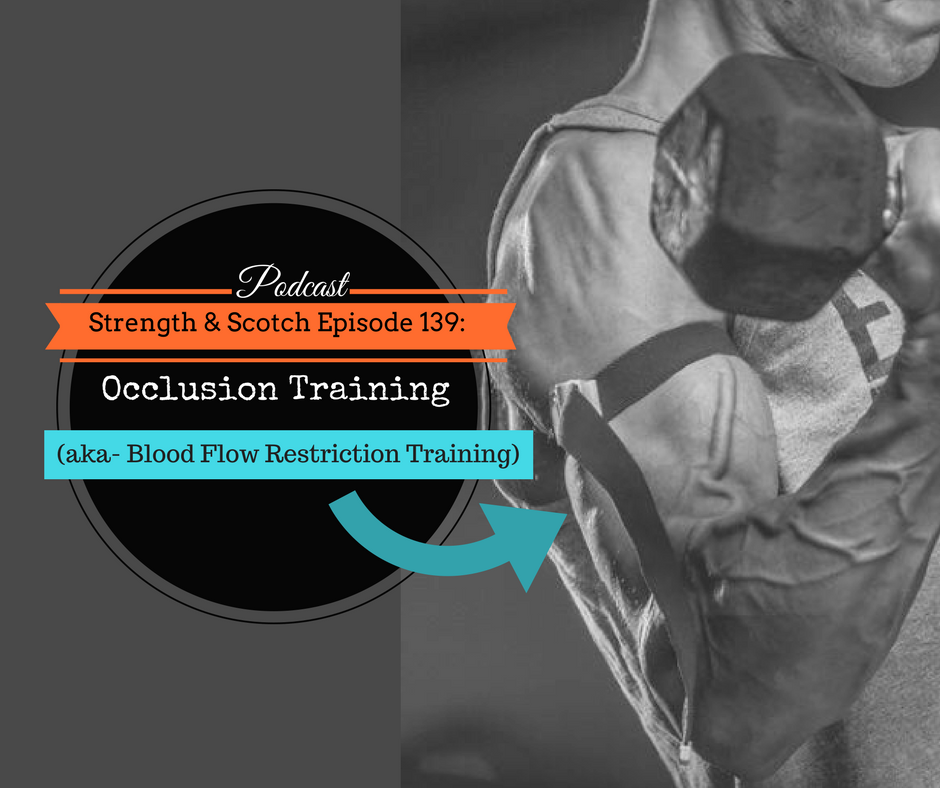SS 139 – Occlusion Training… Silly or Science?
Episode 139 Show Notes
In today’s episode, Grant and Heavey discuss occlusion training, also commonly known as blood flow restriction (BFR) training. Is it a hack? Maybe. But there is good evidence showing the benefits of restricting your blood flow during training (ask the NCAA guys). Also, find out why we shouldn’t totally ignore doctors as Grant shares this interesting story about a baby who died of feeding on alternative milk.
[02:33] Baby Dies of Alternative Milk Diet
Grant shares a story about a baby who died after being fed with alternative milk. This happened in Belgium where two parents who are in their early 30’s own a health food store. They tried to eat and live very healthy and when they had this new baby, Lucas, they felt they were having some problems with store-bought formula. Being health food practitioners themselves, they started feeding their son oat milk, rice milk, buckwheat milk, semolina milk, and quinoa milk, thinking those were healthier than store-bought formula.
This alternative diet that Lucas’ parents gave him led to him weighing only nine pounds at seven months old. He died and the coroner described the baby as emaciated and gray. the parents are both on trial now for murder. The autopsy revealed the baby was severely dehydrated and the stomach was completely empty. The parents never took him to a single doctor. Making matters worse, the prosecutors ripped the irresponsible parents for driving across Belgium to take Lucas to a homeopathic doctor when he was starving instead of going to a nearby hospital. Physician Elisabeth De Greef was quoted as saying, “These kinds of milk, which you can buy in a supermarket, do not contain the necessary proteins, minerals and vitamins.”
[06:17] You Still Need a Doctor
Grant says it’s such a shame when people make this kind of health decisions for children who are unable to make them. But his takeaway from this story is that while we’re trying to promote a lot of healthy lifestyle and nutrition, sometimes you still need a doctor and sometimes we shouldn’t prescribe things to ourselves without understanding what’s really going on. Heavey even says it all the time that he’s not a doctor. A lot of this stuff mentioned here are very factual and apply in a vast majority of cases but sometimes people need help that extends beyond normal nutrition or normal fitness goals.
Heavey adds that this comes down to the treatment of disease that in cases where somebody has a very acute issue, you get to a doctor because that’s what they’re there for. Doctors are there for the treatment of disease, not necessarily promotion of health. If you have a disease, if there’s something wrong, go to a doctor immediately. Alternatively, if you’re trying to improve your all-around health and you don’t have any particular issue or disease-state, that’s where some of those other stuff can come in to improve the quality of your life and improve your longevity. But under no circumstances should you ignore doctors and the scientific community, especially not with the children.
[08:45] What is Blood Flow Restriction Training?
Also called BFR or occlusion training, blood flow restriction training is growing in popularity now. As the name suggests, it means you’re reducing the blood flow to or from your muscles during your lifting. Research shows that you can actually get some pretty substantial benefits by including this type of training in your program.
[09:45] The Story of the Monk
BFR dates back to the 60’s and the guy that came up with it was a monk who was always sitting with his legs crossed and felt like he was cutting off circulation. Somehow this led to this training program where he developed all this sophisticated machinery that can cuff your arms and legs to a very precise pressure level. The machinery costs a couple thousand dollars so it’s not very realistic for people to use.
[10:20] How BFR Training Actually Works
More recently, a lot of the research has been turning to easily accessible methods for restricting blood flow that led to this boom of people implementing this. The most standard approach for people in the gym is the knee wrap. Instead of wrapping them around the knee, people squat with them wrapped higher up around their thighs. As a result, it reduces the venous blood flow which is the blood coming back from the muscles to the heart. If you can get the pressure right then it should not restrict the arterial flow which is the blood going to the muscle.
[11:13] Increased Hypertrophy at Lower Intensities
Through this research, they’ve seen that they can actually increase hypertrophy (building size and strength) at lower rates. What ordinarily may have taken very high intensities, like training at 90%, can now be accomplished at much lower intensities like around 30%.
Heavey thinks this is done in part by recruiting fast-twitch muscles which are the muscles we tend to recruit at those higher intensities but because of the nature of this restricted blood flow, they’re now being recruited when we squat with our blood flow being restricted.
[11:54] Other Possible Effects of Occlusion Training
Other research also shows increased levels of free testosterone for people doing occlusion training as well as substantial levels of elevated growth hormone. Some research also show hypertrophy changes in as little as one week from doing this type of training.
[12:22] A Good Kind of Hack
Heavey admits he is almost always adamantly against hacks but he does see that, at least for certain applications, it’s a very strong case to apply in that a lot of people can use it to augment their training and get more out of their training with less time which is a hack. But it really does seem to work and Heavey has not really found any downsides to it, nor were there any safety concerns that have come up.
[13:17] Getting the Right Blood Flow
Heavey points out that it’s part of the benefit of having that super expensive machinery where you can dial it exactly into the right pressure. For an everyday person using a cheaper equipment, it’s a little more nuanced where you have to practice a little bit to get to it. The idea is to start from a less pressure point and work your way up.
People that are really into exercise often see things as more is always better, but this is not the case with BFR. They’ve shown this bell curve that if you restrict the blood too much then it’s going to cut off the benefits and too little doesn’t have any benefit either so you’re looking for that sweet spot. Also, the knee wrap may be too big if you use it on your arms so the most common tool you can use are medical tourniquets. Tighten them up to about a level of 7 out of 10.
[15:25] It’s Worth a Try!
Heavey is not saying you go ahead and do this but there is some really compelling research about this stuff. He hasn’t tried this but he will be experimenting with it. He first heard about this about three years ago and he continues to see research as it comes up to the point that he believes this is really compelling enough and he would want to give this a shot.
In fact, the NCAA has sanctioned research within football players, specifically on D1 football players. They found an 8% increase in the squat one rep max from the group doing the occlusion training as compared to the control group at 4.95%. That said, there are some legit people applying this research in very real and sanctioned environments, not just backroom stuff.
[16:20] It’s Not for Novices
Grant implies a novice is not going to get the benefit from this nearly as much as they would benefit from dialing in and programming nutrition and sleep. Heavey agrees and would not recommend this for novices since a novice will benefit from doing anything. Therefore, don’t go crazy on your first time around. This may not also be for those who have just been training for a few months.
Heavey suggests this is for people who have been training for a couple of years and they’re looking to get more out of their training. Another reason he would like to experiment this personally is to be able to do this training and know how it feels before he could eventually apply this method to his clients.
[17:15] Post-Injury and the Elderly
Additionally, Heavey cites three interesting applications for these. First, post-injury. If you have massive injury and you’re not able to lift, that window right after surgery is a critical time where you will experience atrophy at a very high rate. By applying this method, you would be able to stave off the atrophy that would have ordinarily occurred while you’re laying on the hospital bed.
Second, this can be applied to elderly populations for body weight exercises. The elderly are fighting an uphill battle, as Heavey would put it, since strength and muscle mass are highly important for old people in terms of maintaining their independence, mobility, and longevity which are all correlated muscle mass. BFR is therefore something to be considered carefully if this means improving their muscle mass.
[19:45] Less Sore Muscles
Studies show that the benefit of BFR come from the restriction of blood flow and not because it provides support. They know lactate levels pool when doing the BFR which accounts for the increase in release of growth hormone so they’re starting to understand some of the mechanisms. This can actually make you less sore because of the lower weights you’re using. It’s still pretty tough workout, just that you’re using lower weights and it’s been shown from much research that the perceived soreness is much lower when working out at lower intensities and with BFR.
[20:55] In-Season Athlete Training
Heavey mentions the third big application for BFR is in-season athlete training. When he worked with NFL guys just coming off season, he was amazed to see how beat up and weak they were at the end of their season. These are professional athletes but he could out-squat them which was pretty silly. Then after coming back in training for two weeks, they were squatting three times as much as Heavey. The point is, during the season, they can’t train that hard. It’s mostly maintenance and staving off what they can in loss of performance. But BFR is kind of a game-changer. It makes sense that NCAA is looking at this since there is less perceived soreness, less risk of injury, and you’re still getting the results from it. They’re trying to introduce this more and we will be seeing this in professional athletics too, if it isn’t yet, where they’re going to be doing this training for athletes. Heavey further explains that a lot of times, you’ll see teams kick ass for the first half of the season and then they fall apart in the second half and a lot of that is just them physically falling apart.
Finally, being the skeptic guy that he is, Grant initially thought he was not going to be convinced but now he wants to give this a try. Heavey is soon moving in with Grant for a few months so they will see how this things would actually go.
Check out the gear page for everything Strength & Scotch! You’ll find a listing of all the supplements and other programs we’ve discussed on the show as well as our killer t-shirts!


